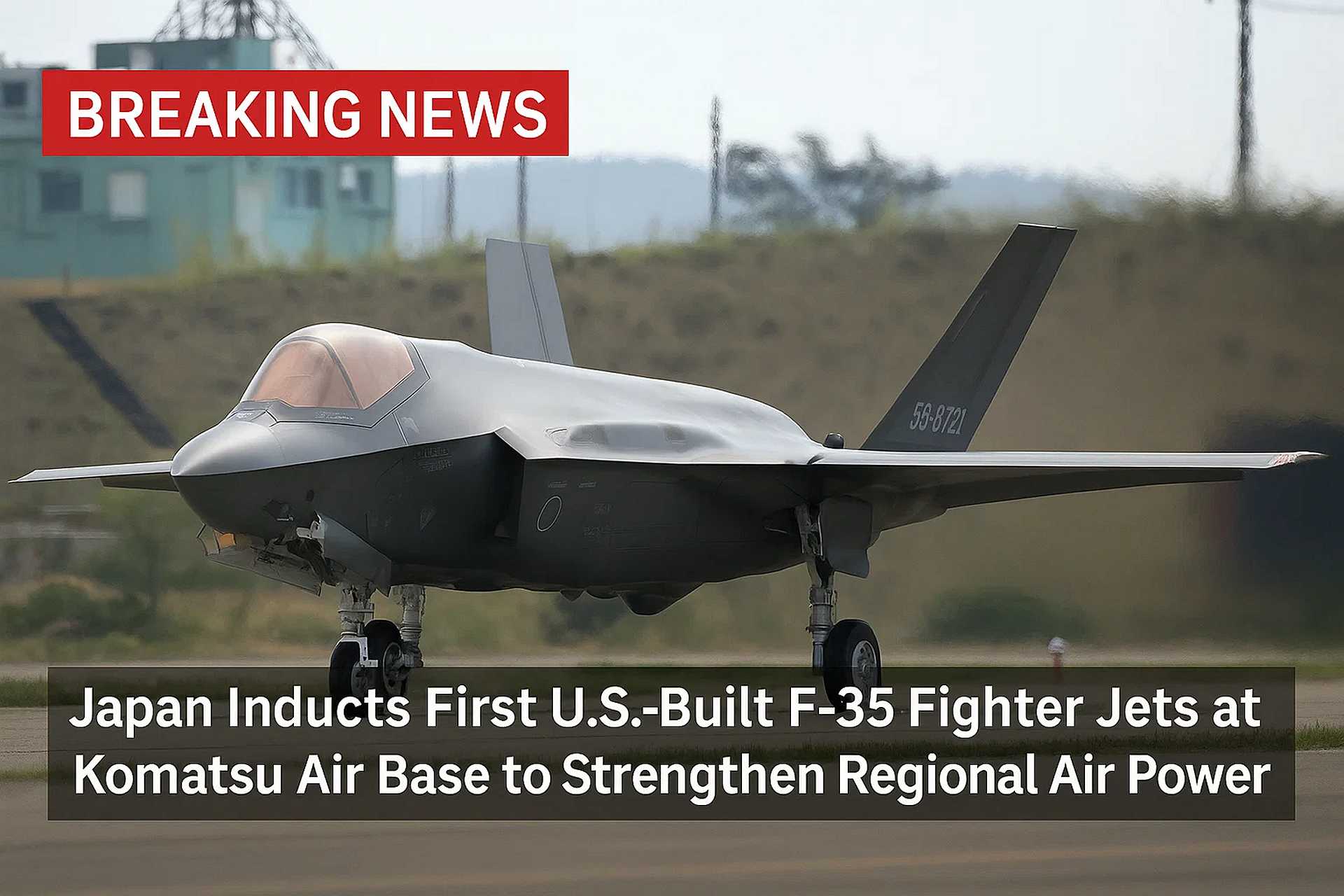Breaking News: Japan Inducts First U.S.-Built F-35 Fighter Jets at Komatsu Air Base to Strengthen Regional Air Power

{loadposition bannertop}
{loadposition sidebarpub}
On April 26, 2025, the Japan Air Self-Defense Force (JASDF) reached a pivotal milestone with the formal induction of its first U.S.-built F-35 Lightning II aircraft at Komatsu Air Base, strategically positioned along Japan’s western seaboard facing the Sea of Japan. This landmark occasion represents a substantial enhancement of Japan’s aerial defense posture and marks a significant progression in the nation’s broader military modernization agenda. The integration of the U.S.-manufactured fifth-generation fighter underscores the deepening defense cooperation between Japan and the United States, while simultaneously establishing a new benchmark in operational readiness and strategic deterrence within the Indo-Pacific security landscape.Follow Army Recognition on Google News at this link
A Japan Air Self-Defense Force F-35 Lightning II touches down at Komatsu Air Base, marking the nation’s first operational deployment of the U.S.-built fifth-generation fighter jet. (Picture source: Japan Air Self-Defense Force)
Komatsu Air Base, known as the only fighter base situated along Japan’s Sea of Japan coast, occupies a crucial position in Japan’s defense architecture. Its geographical location provides a critical vantage point for monitoring and responding to regional threats, especially in light of increasing military activity and geopolitical tensions in the Indo-Pacific region. The deployment of the F-35 fighter jets at this base significantly elevates Japan’s capacity to enforce air superiority and mount rapid, effective responses to emerging security scenarios.
The F-35 Lightning II aircraft represents the pinnacle of fifth-generation fighter technology. With features such as stealth, advanced sensor fusion, and network-centric warfare capabilities, the F-35 provides Japan with a combat platform that is highly adaptable to modern warfare. The new TR-3 configuration, now included in Japan’s fleet, brings upgrades in computational power and electronic warfare systems, ensuring these aircraft remain on the cutting edge. Lt. Col. Ogino “VR” Masaki, the JASDF’s F-35 Program liaison officer, described the delivery as “the beginning of a new chapter for Japan’s F-35 program,” underscoring the achievement as a significant stride toward building a resilient and layered defense structure.
Japan’s journey to acquire and integrate the F-35 into its military framework has been extensive and deliberate. The country has committed to purchasing a total of 147 F-35 aircraft, including 105 F-35A conventional takeoff and landing variants, and 42 F-35B short takeoff and vertical landing (STOVL) variants. This makes Japan the largest international customer of the F-35 program. In August 2023, Japan further increased its order with the acquisition of 15 additional F-35s, signaling unwavering commitment to the platform and its potential to transform the nation’s defense posture.
The inclusion of the F-35B variant, capable of STOVL operations, supports Japan’s strategy to enhance its maritime capabilities. To this end, Japan has undertaken extensive modifications to its Izumo-class helicopter destroyers—JS Izumo and JS Kaga—enabling them to operate these advanced aircraft. This transformation turns the vessels into light aircraft carriers, allowing Japan to project air power from the sea and expand its strategic reach, especially in contested waters.
Beyond the technical enhancements, the integration of the F-35 has been backed by a series of collaborative and interoperable initiatives with partner nations. For instance, in 2024, Japanese officials observed F-35 operations on the Italian aircraft carrier Cavour off Japan’s coast. Later, the JS Kaga hosted U.S. F-35B testing during a mission near San Diego, highlighting the interoperability and deepening alliances among F-35 operating nations. These cooperative efforts have been instrumental in preparing Japan to fully embed the aircraft into its forces—on land, at sea, and in the air.
The strong defense relationship between Japan and the United States has been a cornerstone of Tokyo’s military strategy since the post-WWII era, and it continues to be a critical driver behind major acquisitions like the F-35. The U.S.-Japan alliance underpins Japan’s access to advanced military technologies and platforms. Through the Foreign Military Sales (FMS) program and joint research initiatives, Japan has gained access not only to the F-35 but also to missile defense systems such as Aegis-equipped destroyers and the Patriot PAC-3 missile systems. These acquisitions have reinforced Japan’s multi-layered defense capability, particularly in response to missile threats from North Korea and the growing assertiveness of China in nearby waters.
For Japan, having a strong air force equipped with the F-35 is not just about defense—it’s about securing strategic autonomy and regional influence in an increasingly contested environment. Air superiority ensures the ability to monitor vast maritime and aerial approaches, defend key territories such as the Senkaku Islands, and support broader Indo-Pacific stability. In particular, the F-35’s ability to operate across domains—supporting naval and ground operations with intelligence, surveillance, and reconnaissance (ISR) functions—gives Japan the technological edge to counter modern, high-speed threats and ensure deterrence through capability.
The arrival of the F-35 fighter jets at Komatsu Air Base is not just a delivery—it is the culmination of years of strategic planning, international coordination, and technological preparation. This development strengthens Japan’s ties with the F-35 Joint Program Office and fellow operators, while simultaneously reinforcing its own role as a key player in regional security. In a dynamic and often unstable Indo-Pacific landscape, the F-35’s cutting-edge capabilities offer Japan a critical edge in ensuring peace and stability for decades to come.

{loadposition bannertop}
{loadposition sidebarpub}
On April 26, 2025, the Japan Air Self-Defense Force (JASDF) reached a pivotal milestone with the formal induction of its first U.S.-built F-35 Lightning II aircraft at Komatsu Air Base, strategically positioned along Japan’s western seaboard facing the Sea of Japan. This landmark occasion represents a substantial enhancement of Japan’s aerial defense posture and marks a significant progression in the nation’s broader military modernization agenda. The integration of the U.S.-manufactured fifth-generation fighter underscores the deepening defense cooperation between Japan and the United States, while simultaneously establishing a new benchmark in operational readiness and strategic deterrence within the Indo-Pacific security landscape.
Follow Army Recognition on Google News at this link
A Japan Air Self-Defense Force F-35 Lightning II touches down at Komatsu Air Base, marking the nation’s first operational deployment of the U.S.-built fifth-generation fighter jet. (Picture source: Japan Air Self-Defense Force)
Komatsu Air Base, known as the only fighter base situated along Japan’s Sea of Japan coast, occupies a crucial position in Japan’s defense architecture. Its geographical location provides a critical vantage point for monitoring and responding to regional threats, especially in light of increasing military activity and geopolitical tensions in the Indo-Pacific region. The deployment of the F-35 fighter jets at this base significantly elevates Japan’s capacity to enforce air superiority and mount rapid, effective responses to emerging security scenarios.
The F-35 Lightning II aircraft represents the pinnacle of fifth-generation fighter technology. With features such as stealth, advanced sensor fusion, and network-centric warfare capabilities, the F-35 provides Japan with a combat platform that is highly adaptable to modern warfare. The new TR-3 configuration, now included in Japan’s fleet, brings upgrades in computational power and electronic warfare systems, ensuring these aircraft remain on the cutting edge. Lt. Col. Ogino “VR” Masaki, the JASDF’s F-35 Program liaison officer, described the delivery as “the beginning of a new chapter for Japan’s F-35 program,” underscoring the achievement as a significant stride toward building a resilient and layered defense structure.
Japan’s journey to acquire and integrate the F-35 into its military framework has been extensive and deliberate. The country has committed to purchasing a total of 147 F-35 aircraft, including 105 F-35A conventional takeoff and landing variants, and 42 F-35B short takeoff and vertical landing (STOVL) variants. This makes Japan the largest international customer of the F-35 program. In August 2023, Japan further increased its order with the acquisition of 15 additional F-35s, signaling unwavering commitment to the platform and its potential to transform the nation’s defense posture.
The inclusion of the F-35B variant, capable of STOVL operations, supports Japan’s strategy to enhance its maritime capabilities. To this end, Japan has undertaken extensive modifications to its Izumo-class helicopter destroyers—JS Izumo and JS Kaga—enabling them to operate these advanced aircraft. This transformation turns the vessels into light aircraft carriers, allowing Japan to project air power from the sea and expand its strategic reach, especially in contested waters.
Beyond the technical enhancements, the integration of the F-35 has been backed by a series of collaborative and interoperable initiatives with partner nations. For instance, in 2024, Japanese officials observed F-35 operations on the Italian aircraft carrier Cavour off Japan’s coast. Later, the JS Kaga hosted U.S. F-35B testing during a mission near San Diego, highlighting the interoperability and deepening alliances among F-35 operating nations. These cooperative efforts have been instrumental in preparing Japan to fully embed the aircraft into its forces—on land, at sea, and in the air.
The strong defense relationship between Japan and the United States has been a cornerstone of Tokyo’s military strategy since the post-WWII era, and it continues to be a critical driver behind major acquisitions like the F-35. The U.S.-Japan alliance underpins Japan’s access to advanced military technologies and platforms. Through the Foreign Military Sales (FMS) program and joint research initiatives, Japan has gained access not only to the F-35 but also to missile defense systems such as Aegis-equipped destroyers and the Patriot PAC-3 missile systems. These acquisitions have reinforced Japan’s multi-layered defense capability, particularly in response to missile threats from North Korea and the growing assertiveness of China in nearby waters.
For Japan, having a strong air force equipped with the F-35 is not just about defense—it’s about securing strategic autonomy and regional influence in an increasingly contested environment. Air superiority ensures the ability to monitor vast maritime and aerial approaches, defend key territories such as the Senkaku Islands, and support broader Indo-Pacific stability. In particular, the F-35’s ability to operate across domains—supporting naval and ground operations with intelligence, surveillance, and reconnaissance (ISR) functions—gives Japan the technological edge to counter modern, high-speed threats and ensure deterrence through capability.
The arrival of the F-35 fighter jets at Komatsu Air Base is not just a delivery—it is the culmination of years of strategic planning, international coordination, and technological preparation. This development strengthens Japan’s ties with the F-35 Joint Program Office and fellow operators, while simultaneously reinforcing its own role as a key player in regional security. In a dynamic and often unstable Indo-Pacific landscape, the F-35’s cutting-edge capabilities offer Japan a critical edge in ensuring peace and stability for decades to come.





